On April 14, 1912, the RMS Titanic fatefully struck an iceberg that broke off the coast of Greenland the same year that construction on the ship began.
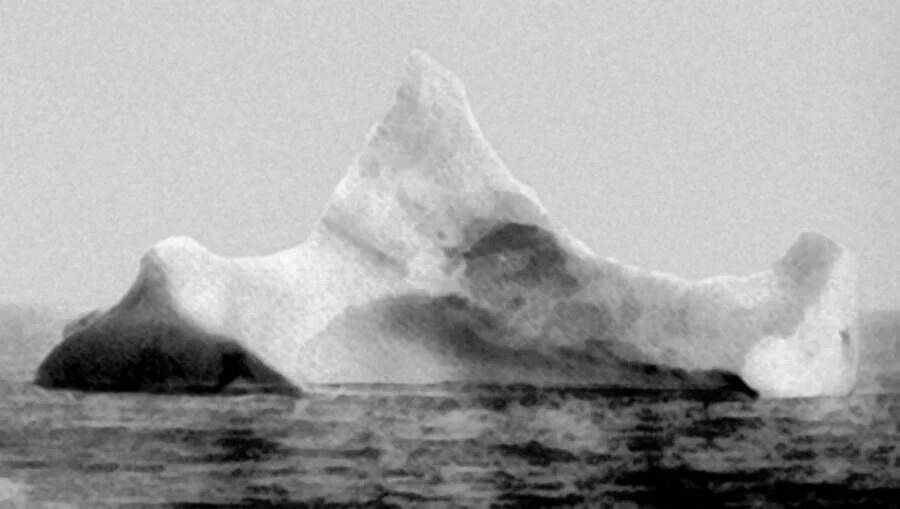
Wikimedia CommonsThis is a photo of the suspected Titanic iceberg, which was reportedly marked with a smear of red paint.
The story of the Titanic is ultimately one of a fatal encounter. On one side, there was the RMS Titanic, a ship built by White Star Line. On the other side, there was the Titanic iceberg, floating in the North Atlantic.
Both began their journey in 1909. And in April 1912, they’d catastrophically collide, sinking the ship and plunging the iceberg into nautical infamy.
Though the story of the British ocean liner is well-known, the iceberg itself is often only mentioned in retellings of the collision. Here’s everything you need to know about the Titanic iceberg that sank the doomed vessel.
The Titanic Iceberg: A Story Thousands Of Years In The Making
The full story of the Titanic iceberg technically began approximately 15,000 years ago, when snow fell over sheets of ice in modern-day Greenland. The snow eventually compacted into solid ice, and as the millennia passed, the resulting glacier gradually inched toward Greenland’s coast.

Public DomainA possible photo of the Titanic iceberg, which was taken on April 12, 1912 — two days before the ship sank.
Ice grows weaker as it nears the water, and the Titanic iceberg was likely “born” in 1909. Though some 40,000 icebergs break off the coast of Greenland each year, experts believe the Titanic iceberg came specifically from the Ilulissat ice shelf. It may have been the only one that year.
From that point, the newly born iceberg would have slowly floated away from the coast. As Smithsonian Magazine reported in 2022, it probably drifted north, toward the North Pole, before the Labrador current pulled it south. From then on, the Titanic iceberg survived incredible odds.
Most icebergs melt within a year or two. But the Titanic iceberg not only outlasted that time period, it also became one of the rare icebergs to make it through the warmer waters of the Gulf Stream. Just a handful of icebergs — between one and four percent — make it this far.

Texas State UniversityThe possible path that the Titanic iceberg took toward its fatal collision with the Titanic itself.
By the spring of 1912, the iceberg had made it to the transatlantic shipping lanes off the coast of Newfoundland. And it would soon have a catastrophic collision with the Titanic, a ship once thought to be “unsinkable.”
“Iceberg, Right Ahead!”
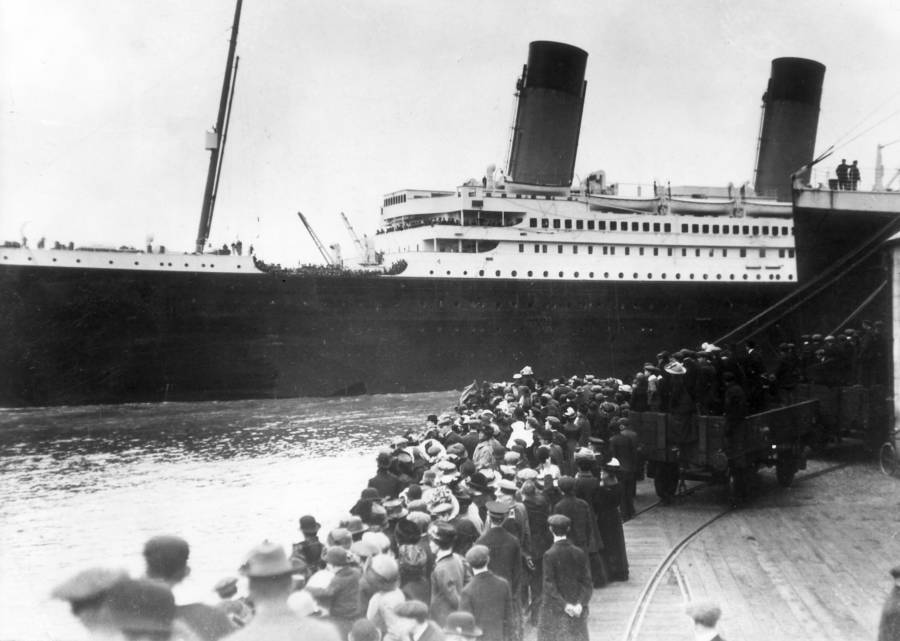
ullstein bild/ullstein bild via Getty ImagesThe RMS Titanic set to depart from Southampton, England. April 10, 1912.
Construction on the RMS Titanic began in 1909, the same year that the Titanic iceberg was “born.” Constructed at the Harland and Wolff shipyard in Belfast, Ireland, the ship quickly garnered attention for its massive size, its opulent amenities, and the fact that the vessel was allegedly unsinkable.
“I took passage on the Titanic for I thought it would be a safe steamship and I had heard it could not sink,” Titanic survivor Margaret Devaney, a third-class passenger who was from Ireland, later recalled.
The Titanic set sail on its maiden voyage on April 10, 1912, from Southampton, England to New York City. Captained by Edward Smith, an experienced seaman, the estimated 2,240 passengers and crew members had little to fear. But that changed just a few days later, on April 14th.
Warnings about icebergs trickled in during the day. Several ships, including the SS Californian and the SS Mesaba, sent messages to the Titanic about large, potentially dangerous icebergs in the area. At night, the Californian even notified the Titanic that they had stopped sailing due to the amount of ice nearby. However, the Titanic’s radio operator — overwhelmed with telegrams — reportedly responded: “Shut up! I am busy.”
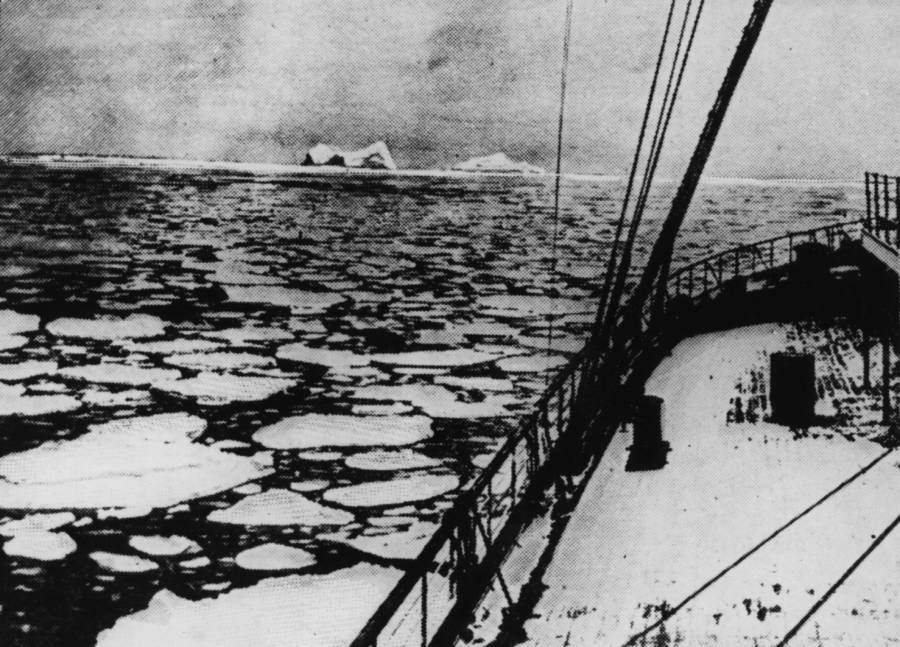
Hulton Archive/Getty ImagesThe icy waters where the Titanic sank, as seen 10 days earlier on April 4, 1912.
At that point, the Titanic iceberg was perilously close to the ship.
But even as the ship sped closer, no one noticed the iceberg on the moonless night until it was too late. At 11:39 p.m., a lookout named Frederick Fleet finally caught a glimpse of the looming danger and cried: “Iceberg, right ahead!” Less than a minute later, the Titanic and the iceberg collided.
As survivors later estimated, the iceberg measured between 50 and 100 feet high above the waterline and stretched about 200 to 400 feet long. During the collision, the iceberg quickly ripped a hole in the starboard side of the Titanic, literally puncturing the myth that the ship could not sink.
Over the next two hours and 40 minutes, the Titanic sank into the frigid waters of the North Atlantic. Under the cold gaze of the Titanic iceberg, some 1,500 people perished. Just 706 people on board managed to survive.
But the story of the Titanic iceberg doesn’t quite end there.
What Happened To The Titanic Iceberg?
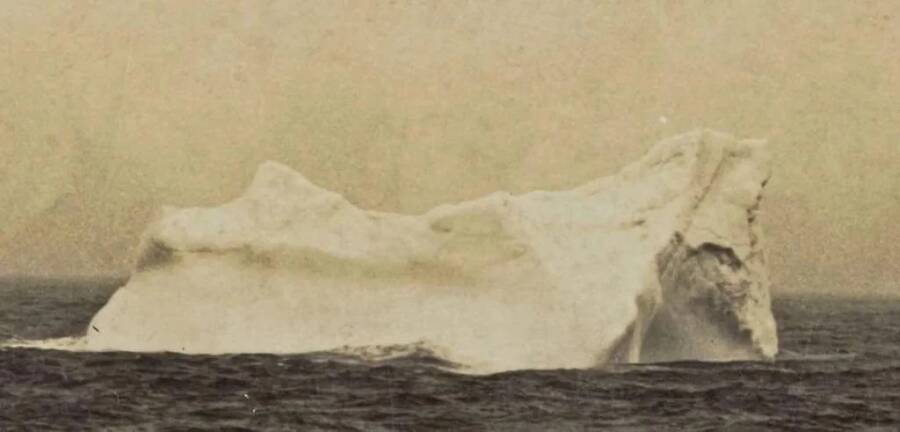
Titanic Historical SocietyThis photo, taken by Stephan Rehorek on the German steamer Bremen, may show the Titanic iceberg.
A few days after the Titanic disaster, the German steamer Bremen arrived on the scene. Horrified passengers on the steamer could reportedly see bodies in the water, what remained of the Titanic wreck, and icebergs nearby. Passenger Stephan Rehorek snapped a photo of one particular iceberg, seen above, which is likely the Titanic iceberg itself. Indeed, Titanic seaman Joseph Scarrott had described the iceberg as resembling the “Rock of Gibraltar,” and the Rehorek photo appeared to match the description.
Several more possible photos of the iceberg exist, but people wouldn’t be able to document it for long. About two weeks after the sinking of the Titanic, the iceberg likely melted into the sea. Though it had survived for a long time, it was no match for the warmer waters it eventually encountered.
Naturally, the iceberg is blamed today for the sinking of the Titanic. But some have wondered whether other factors played a role in the disaster.
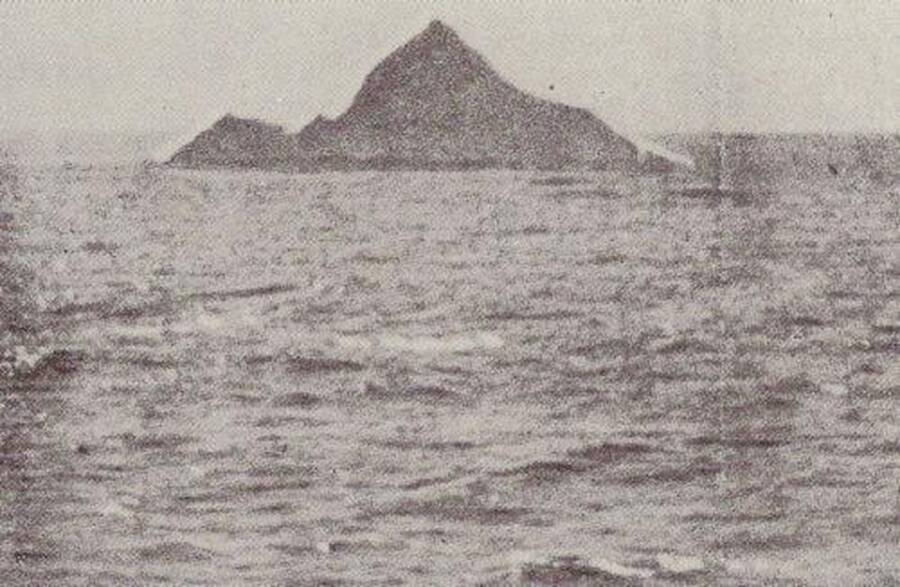
Public DomainPurportedly a photo of the Titanic iceberg, taken from the SS Birma on April 15, 1912.
For starters, the Titanic was traveling at a high rate of speed when it hit the iceberg — 20.5 knots (23.6 miles per hour). Secondly, modern research has suggested that the ship was constructed with low-quality rivets in some sections, including where the iceberg struck. And it’s even possible that a coal fire on the Titanic had weakened the vessel’s hull before the collision.
Regardless, the Titanic iceberg demonstrated the desperate need for better iceberg precautions while traveling by ship. As the BBC reported in 2012, world leaders held the first Safety of Life at Sea convention to address such dangers in the aftermath of the vessel’s sinking. They came up with solutions like the International Ice Patrol, which monitors “Iceberg Alley” to this day. In modern times, satellite technology also helps sailors watch out for icebergs — though, unfortunately, iceberg strikes still happen.
Today, the Titanic remains in its final resting place 13,000 feet beneath the ocean’s surface about 400 miles east of Newfoundland. The site is strewn with Titanic artifacts and acts as an eerie reminder of the tragedy. But the iceberg is long gone. More than a century has passed since it melted away.
Of course, it remains a starring character in the Titanic saga. Some 15,000 years after it first began to form, the Titanic iceberg set out on a voyage that would put it directly in the path of the doomed ship. On that fateful night in 1912, both the iceberg and the Titanic reached their final destination.
After reading about the iceberg that sank the Titanic, discover the incredible stories of the people who survived the sinking, including R. Norris Williams, a young tennis player who witnessed the ship raise up and sink into the North Atlantic, and the “unsinkable” Molly Brown, who quickly organized the wealthiest survivors to help the least fortunate.





